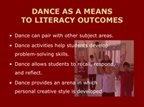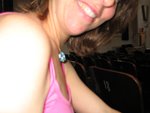Dance is Language

I made a PowerPoint presentation for my Tech Resources class where I had to research how literacy is acquired through the arts. I specifically tailored my presentation to be geared towards dance, but the principles are transferrable to any art form. In one of the articles I found particularly interesting, there was mention of the concept of treating each art as a language. Dance is one of the disciplines that can aid in developing and acquiring literacy. Dance is a language, and as skills are developed in the dance framework, they translate into other literacy skills. Through the medium of physical and emotional expression, students will experience another facet of themselves and make connections with other knowledge. Developing a common language with which to discuss and create dance will allow for new experiences that will enhance literacy among students. As you acquire skills and comprehension in any language, you are also making links to literacy areas you already possess. I began to understand English grammar for the first time when I took high school French. While learning the new language, somehow I was making connections that gave me a framework for the language I spoke fluently.
Fluency is the ability to communicate in a language easily and quickly, like a native speaker of the language. So it is with dance; as you move towards fluency, you make connections to your native language, and it enhances your knowledge in both languages. I can gear my lessons around some of the grammar that is used in dance, including:
Fluency is the ability to communicate in a language easily and quickly, like a native speaker of the language. So it is with dance; as you move towards fluency, you make connections to your native language, and it enhances your knowledge in both languages. I can gear my lessons around some of the grammar that is used in dance, including:
- Dance vocabulary: steps, movements; a descriptive way of speaking about movement
- Dance phrase: incorporating a number of steps or movements in a sequence
- Story: complete dance piece made up of many dance phrases
- Rules of grammar: order, how things go together, what makes sense
- Techniques for generating ideas: brainstorming, found movement, improvisation, inspiration from personal experiences, photos, or poems, etc.
- Structure: form (ie.: ABA, ABBA, ABCDEBC, etc.)
- Editing: objectively viewing the work, openness to appropriately given criticism, and then being able to cut, paste, delete, and rearrange as necessary



1 Comments:
I also think dance is language in a different level. For example, if we go to other countries where we do not have a common language with local people, body language works.. isn't it?
In order to communicate with others, therefore, I think we need to have shared language or symbols. If we had a universal language in dance, it would be great in dance fields!! And I think it is not impossible!
Post a Comment
<< Home